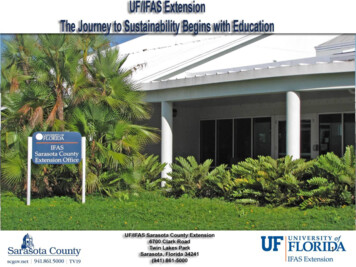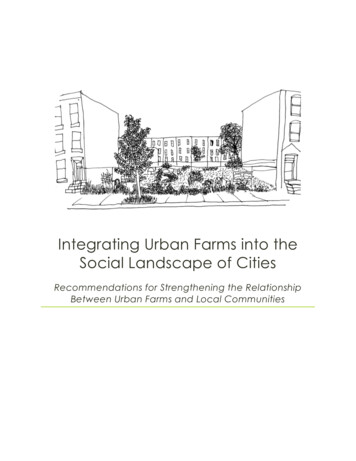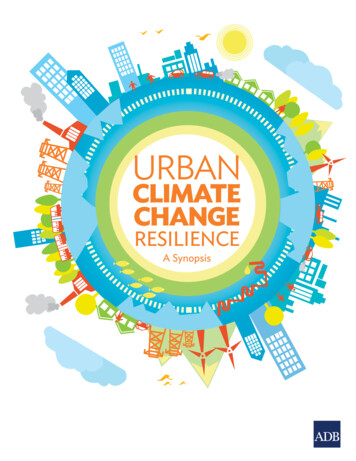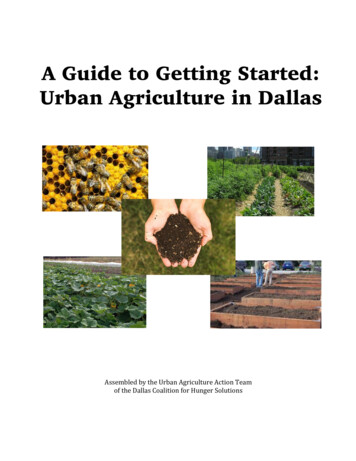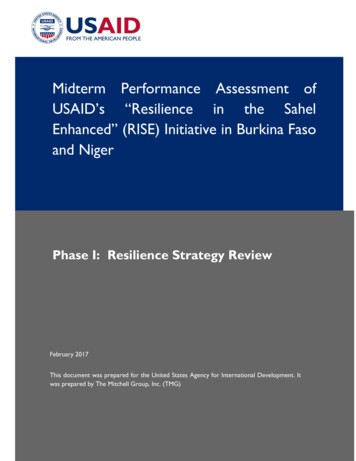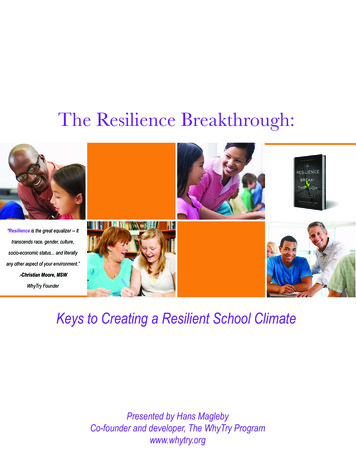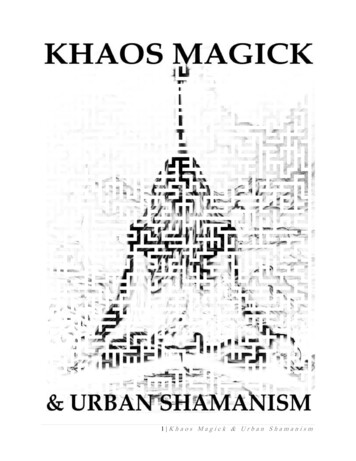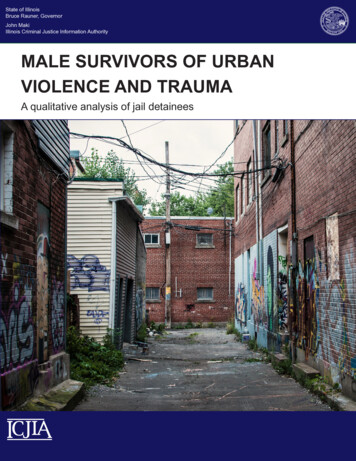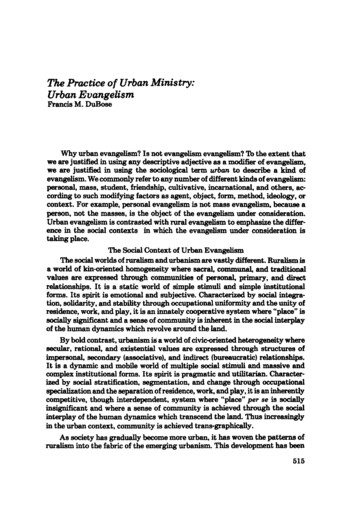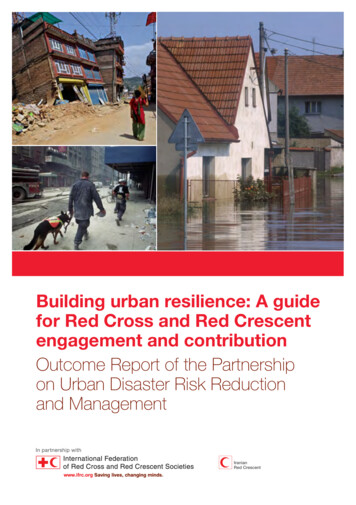
Transcription
Building urban resilience: A guidefor Red Cross and Red Crescentengagement and contributionOutcome Report of the Partnershipon Urban Disaster Risk Reductionand Management
International Federation of Red Crossand Red Crescent Societies, Geneva, 2017Copies of all or part of this manual may be made fornoncommercial use, providing the source is acknowledged.The IFRC would appreciate all requests being directed to theIFRC at secretariat@ifrc.org.The opinions and recommendations expressed in this manualdo not necessarily represent the official policy of the IFRC orof individual National Red Cross or Red Crescent Societies.The designations and maps used do not imply the expressionof any opinion on the part of the IFRC or National Societiesconcerning the legal status of a territory or of its authorities.All photos used in this manual are copyright of the IFRCunless otherwise indicated.Cover photo: Mithila Jariwala/IFRC, Daniel Cima/IFRCAndrew McColl/IFRCBuilding urban resilience: A guide for Red Crossand Red Crescent engagement and contribution1317300 03/2017 EP.O. Box 303CH-1211 Geneva 19, SwitzerlandTel : 41 22 730 4222Fax: 41 22 730 4200E-mail: secretariat@ifrc.orgWeb site: www.ifrc.org
Building urban resilience:A guide for Red Cross andRed Crescent engagementand contributionOutcome Report of the Partnershipon Urban Disaster Risk Reductionand ManagementThe International Federation of Red Cross andRed Crescent Societies (IFRC) is the world’slargest volunteer-based humanitarian network.With our 190 member National Red Crossand Red Crescent Societies worldwide, we arein every community, reaching 160.7 millionpeople annually through long-term servicesand development programmes, as well as110 million people through disaster responseand early recovery programmes. We actbefore, during and after disasters and healthemergencies to meet the needs and improvethe lives of vulnerable people. We do so withimpartiality as to nationality, race, gender,religious beliefs, class and political opinions.Guided by Strategy 2020 – our collective plan ofaction to tackle the major humanitarian anddevelopment challenges of this decade – we arecommitted to saving lives and changing minds.Our strength lies in our volunteer network,our community-based expertise and ourindependence and neutrality. We work toimprove humanitarian standards, as partners indevelopment, and in response to disasters. Wepersuade decision-makers to act at all times inthe interests of vulnerable people. The result: weenable healthy and safe communities, reducevulnerabilities, strengthen resilience and fostera culture of peace around the world.
International Federation of Red Cross and Red Crescent SocietiesBuilding urban resilience Table of ContentsAcknowledgement5Acronyms and abbreviations7Introduction9Chapter 1. Introduction to the guideBackgroundThe role of the MovementWhat is urban resilience?Recent global developments on urban resilienceagainst disastersWhy a guide on urban resilience for the Red CrossRed Crescent Movement?Purpose of this guideHow the guide was developedWhen and how to use the guideWhat the guide does not doIntended audience13131516192223242525Chapter 2. Context and engagementDefining an urban areaDefining urban communitiesUnderstanding disaster riskMulti-sector, multi-stakeholder engagement2628292931Chapter 3. Capacity-strengthening36Chapter 4. Awareness-raising42Chapter 5. Programme implementation/activitiesEntry pointsProgramme-related considerations464648183
International Federation of Red Cross and Red Crescent SocietiesBuilding urban resilienceChapter 6. Advocacy65Chapter 7. Red Cross Red Crescent essentialsfor building urban resilience69Chapter 8. Key documents and resources for Urban DisasterRisk Reduction and Management794Annex 1. UNISDR – Ten Essentials for Making Cities Resilient83Annex 2. Global developments on Urban Resilience85Annex 3. Tehran Call for Action91Annex 4. The Road to Urban Resilience: The IFRC’s Perspective 94
International Federation of Red Cross and Red Crescent SocietiesAcknowledgementsAcknowledgementsSpecial thanks to the Iranian Red Crescent Society as the IFRC’sprincipal partner for the global Partnership on Urban DisasterRisk Reduction and Management.People and the National Societies who directly contributed to thePartnership and its outcomes include:ÌÌ Mostafa Mohaghegh, Manager of Partnershipfor Urban DRR/DM, IFRCÌÌ Graham Saunders, Team Leader, Global Networks &Operations Practice , IFRCÌÌ Ela Serdaroglu, Shelter Lead, IFRCÌÌ Sandra D’Urzo, Senior Officer, Shelter and Settlements, IFRCÌÌ Mohammed Mukhier, former Head of CommunityPreparedness and Risk Reduction, IFRCÌÌ Aynur Kadihasanoglu, Senior Advisor Urban DRR,American Red CrossÌÌ Raimond Duijsens, Program Co-ordinator, Partners forResilience, the Netherlands Red CrossÌÌ Samuel Carpenter, former Humanitarian Policy Adviser,British Red CrossÌÌ Arifin Muhammad Hadi, Head of Disaster Management,Indonesian Red Cross (PMI)ÌÌ Muli Elijah, Head of Programme Disaster Risk Management,Kenyan Red CrossÌÌ Michel José Manuel, Chief of the National Health Unit,Bolivian Red CrossÌÌ Edmon Azaryan, Head of Disaster Management andPopulation Movement Department, Armenian Red CrossÌÌ Shahabeddin Mohammadi Araghi, Under-Secretary Generalfor International Affairs and IHL, Iranian Red CrescentSociety5
International Federation of Red Cross and Red Crescent SocietiesBuilding urban resilienceÌÌ Mansoureh Bagheri, Director of International Operations andProgrammes, Iranian Red Crescent SocietyÌÌ Davood Pourkhanali, IFRC Representative in IranÌÌ Lois Austen, ConsultantMany other National Societies and partners as well as IFRCRegional and Country Offices actively participated.6
International Federation of Red Cross and Red Crescent SocietiesAcronyms and abbreviationsAcronyms and DRVCAWDRCommunity based organisationDisaster managementDisaster risk reductionFocus group discussionInternational Federation of Red Crossand Red Crescent SocietiesInternational Red Cross and Red Crescent MovementNon-governmental organizationNational SocietiesSendai Framework for Disaster RiskReduction 2015‑2030United Nations International Strategyfor Disaster ReductionVulnerability and capacity assessmentIFRC World Disasters’ Report7
Italian Red Cross
International Federation of Red Cross and Red Crescent SocietiesIntroductionIntroductionCities and urban areas provide important opportunities for thedevelopment of communities and nations. But risks caused byrapid and often improper urbanization compounded by naturalhazards create some of the major challenges in the 21st Century.It is estimated that by 2050 66 per cent of the world’s populationwill be urban, while rapid and unplanned urbanization will alsocontinue to see a dramatic rise in informal settlements. Asidefrom the negative impacts of improper urbanization on socioeconomic development, the risks and humanitarian consequences of rapid urbanization are alarmingly increasing. Majordisasters occurring in various parts of the world in the pastdecade have created more losses and damages in cities than inother areas.The International Federation of Red Cross and Red CrescentSocieties (IFRC) and its members in 190 countries have alwaysbeen present in cities to respond to crises and disasters and provide relief and humanitarian assistance. But rapid urbanizationand the increasing complexity in urban contexts require betterunderstanding of risk factors and sources of vulnerability and exploring innovative ways for effective disaster risk reduction andresponse and cooperation with other stakeholders. Developingcommunity resilience in relation to disasters in cities hasalso been a new challenge for the Red Cross and Red CrescentMovement in view of the multi-faceted and new causes of vulnerability in urban environments.Considering the above imperatives, the IFRC has taken a numberof measures in recent years to respond to the increasing needsin this area. The IFRC World Disasters Report in 2010 was dedicated to “Urban Risks” and a number of regional surveys wereconducted in the Americas and Asia Pacific region in order to9
International Federation of Red Cross and Red Crescent SocietiesBuilding urban resilienceimprove the understanding of trends in urban risk and explorenew and innovative ways for effective engagement in cities andurban areas. Moreover, several Red Cross Red Crescent NationalSocieties as well as the International Committee of the Red Crosshave included specific initiatives on urban risk in their programmes and contributed to the further development of urbanrisk reduction in the Red Cross and Red Crescent Movement’sactivities.Given the importance of a global and comprehensive approachto urban risk, the IFRC and the Iranian Red Crescent Society concluded an Agreement in February 2013 on the “Partnership forUrban Disaster Risk Reduction and Management” with the aim ofenhancing the IFRC and member National Societies’ capacities todeepen the current understanding of urban trends, provide strategic solutions to face the increasing needs in cities and to develop an IFRC strategy on urban resilience. The Partnership hasbeen implemented from 2013 until 2016 through desk reviewsand studies, regional consultations with the participation of over80 National Societies and partners, implementation of five citylevel projects in Jakarta, La Paz, Nairobi, Tehran and Yerevan andexpansion of cooperation with the IFRC external partners. Theresults of regional consultations and city level projects were presented to the IFRC’s International Seminar on Urban Disaster RiskReduction and Management in Tehran in May 2015 which adoptedthe “Tehran Call for Action” and “Road to urban resilience, theIFRC perspective”.10
International Federation of Red Cross and Red Crescent SocietiesIntroductionThis Guide is one of the outcome documents of the Partnershipon Urban Disaster Risk Reduction and Management and hasbeen prepared to share the key findings of the Partnership andto contribute to the effective engagement of National Societiesin responding to urban risks and enhancing urban resilience.Considering the increasing trends of urban risks, I hope we cando more to reduce these risks and better assist disaster affectedand vulnerable people in cities.Jagan ChapagainUnder Secretary GeneralProgrammes and OperationsInternational Federation of Red Cross and Red Crescent Societies11
Laila Tawakkol, SARC/Homs Branch
International Federation of Red Cross and Red Crescent Societies1. Introduction to the guide1. Introduction to the guideBackgroundRapid urbanization coupled with climate change and other riskswill constitute key issues in the coming decades facing the humanitarian community. It is estimated that by 2050, 66 per cent ofthe world’s population will be urban,1 while rapid and unplannedurbanization will also continue to see a dramatic rise in informalsettlements. Currently, it is estimated that 863 million peoplelive in informal settlements (i.e. squatter and slum settlements).2This rise in unplanned and poorly managed urbanization posesgrowing threats to people’s lives, livelihoods, economic growth,environmental sustainability and social equity as public authorities lack the capacity to effectively provide basic publicservices to a rapidly growing population. Rapid and unplannedurban population growth coupled with the rise in informal settlements in hazard-prone areas has generally surpassed the abilityof public authorities to respond with effective planning and hasthus resulted in increased vulnerability of communities to risk.Urban populations face a number of critical issues, including lim ited access to basic services (e.g., clean water, drainage, sanitation, transport), poor healthcare and education, lack of adequateshelter/ housing on safe land, lack of or inadequate security oftenure, and urban violence, migration and epidemics.The International Red Cross and Red Crescent Movement (theMovement) has a history of being present and active in bothurban and rural areas. However, the Movement’s capacity andaction has historically been more focused on assisting the mostvulnerable people in rural and less developed areas rather than12United Nations, Department of Economic and Social Affairs, Population Division(2014), World Urbanisation Prospects: The 2014 Revision, Highlights (NY, United Nations).UN-HABITAT (2013), Streets as Public Spaces and Drivers of Urban Prosperity (Nairobi,UN-HABITAT).13
International Federation of Red Cross and Red Crescent SocietiesBuilding urban resiliencein complex urban contexts. As a major step towards addressingthis gap, the IFRC 2010 World Disasters Report (WDR) was dedicated to urban risk.1 The 2010 WDR echoed global concerns inrelation to urban disaster risk and called for effective action bythe IFRC and Red Cross Red Crescent National Societies (NationalSocieties) for an increased focus on risk reduction in urban areas.As a result, a number of major initiatives on urban disaster riskreduction (DRR) and disaster management (DM) were developedby the IFRC and by a number of National Societies. One of theinitiatives that was developed was a partnership between theIFRC and the Iranian Red Crescent Society which aimed to support Red Cross and Red Crescent activities in urban DRR and DM.The objective of the partnership (which ran from 2013 to 2016)was to strengthen National Societies’ capacity to support resilience building and enhance disaster preparedness and responsein urban areas through:1. Scaling up Red Cross and Red Crescent activities to reduceurban disaster risks and vulnerability.2. Strengthening Red Cross and Red Crescent capacities to effectively respond to urban disasters.In order to achieve this objective, city level projects were conducted in five selected cities. 2 These initiatives confirmed thegaps in the Movement’s understanding of the urban risk contextand endorsed the need for an IFRC global position and strategy onurban disaster risk reduction as well as the necessity for developing the capacity of National Societies for effective engagementin urban risk reduction and management. As part of the partnership, practical steps toward addressing urban DRR and DM havebeen taken in order to enhance National Society engagement inurban risk reduction. For example, regional workshops on urbanDRR/DM have been held in Africa, Asia & Pacific, the d-reports/world-disasters-report/wdr2010/.Jakarta, La Paz, Nairobi, Tehran and Yerevan.
International Federation of Red Cross and Red Crescent Societies1. Introduction to the guideand the Middle East/North Africa (MENA) regions. The findingsfrom the pilot studies and regional workshops have been used todevelop this guide which is one of the partnership outputs.This guide is the final outcome document of the partnership between the IFRC and the Iranian Red Crescent on Urban DRR and DM.The role of the MovementIt is well recognized that strengthening resilience to disastersincludes disaster management as well as being an essentialcomponent of all emergency and development programming.Communities and households with sustainable livelihoods, goodlevels of health care and access to strong and accountable civilsociety are less susceptible to hazards and recover more quicklyfrom disasters. It is also important that development gains areprotected from disaster.3The IFRC has made it a priority to ensure that building resilienceand DRR is an integral part of its development work and that allits programmes work towards DRR in an integrated and mutuallysupportive way. This requires working at all levels:– Governance.– Policy.– Management.– Practice.There is a clear role for National Societies in supporting urbancommunities to achieve resilience both through integrated RedCross Red Crescent programming on community preparedness,health and first aid, food security, and livelihoods and also byinfluencing local development and urban planning through advocacy, strategic alliances and active ion/building-safer-and-resilient-communities/.15
International Federation of Red Cross and Red Crescent SocietiesBuilding urban resilienceWorking towards urban resilience requires multi-dimensionaland multi-sector approaches to address the underlying driversof risk such as migration, violence, climate change and culturalchanges. Ensuring that its activities work towards strengthenedurban resilience will require the Movement to work holistically,encompassing multi-dimensional and cross-sector methodologieswhich may in some cases require a change in existing approach.What is urban resilience?Resilience is frequently considered to be a bridge between longterm development work and humanitarian response to crisis anddisaster. Resilience activities require an understanding of levelsof exposure to hazards in order that responses can be appropriately designed.The UNISDR defines resilience as: “The ability of a system, community or society exposed to hazards to resist, absorb, accommodate to and recover from the effects of a hazard in a timely andefficient manner, including through the preservation and restoration of its essential basic structures and functions”.1For the IFRC, resilience is defined as:2The ability of individuals, communities, organizations, or countries exposed to disasters and crises and underlying vulnerabilities to:ÌÌ anticipate,ÌÌ reduce the impact of,ÌÌ cope with,ÌÌ and recover fromthe effects of shocks and stresses without compromising theirlong-term prospects.1216UNISDR, Terminology (2009), www.unisdr.org.IFRC, Framework for Community Resilience (2014).
International Federation of Red Cross and Red Crescent Societies1. Introduction to the guideWhilst there is no common definition of what “urban” is, urbanareas generally feature the following characteristics:ÌÌ Dynamism and population mobility.ÌÌ Scale and population density.ÌÌ Population diversity.ÌÌ Varied livelihoods and economic systems.ÌÌ The presence of large informal settlements.ÌÌ Moving front lines, opportunistic criminality and accessproblems.ÌÌ Reduction in basic services.ÌÌ Reliance on information technology.ÌÌ Cash-based economy.Due to different national definitions, “urban” needs to be definedon a context by context basis. Figure 1 below highlights some ofthe key features associated with urban areas in terms of density,diversity and dynamics.Figure 1. Key features of urban �PopulationBuildingsInfrastructureLivelihood itiesPopulation Vulnerability* Adapted from Campbell, L. Stepping back – Understanding cities and their systems (ALNAP/ODI, 2016)17
International Federation of Red Cross and Red Crescent SocietiesBuilding urban resilienceRecent global developmentson urban resilience against disastersRecent years have seen a number of global developments in relation to urban resilience. In addition to the Movement’s own urbanresilience initiatives, the following have been utilized to help inform this guide.1The 2030 Agenda for Sustainable Development has dedicated oneof its 17 sustainable development goals to urban resilience. Goal11 aims to make cities and human settlements inclusive, safe,resilient and sustainable. It focuses on safe housing for the mostvulnerable; access to public transport; reducing disaster-relateddeaths; and providing support and links between urban, periurban and rural areas.The Sendai Framework for Disaster Risk Reduction 2015-2030(SFDRR) aims to prevent new and reduce existing disaster riskthrough the integration of a range of measures that preventhazard exposure and vulnerability to disaster, increase preparedness for response and recovery and strengthen resilience. TheSFDRR encourages strengthened disaster risk governance with afocus on the built environment and encourages investing in DRRfor resilience purposes. In addition, the need to incorporateDRR measures into multilateral and bilateral development assistance programmes is highlighted.One of the key priorities emanating from the Climate ChangeConference, Paris (2015) (COP21) was establishing a global goal of“enhancing adaptive capacity, strengthening resilience and reducing vulnerability to climate change”.118See Annex 2 for further detail.
International Federation of Red Cross and Red Crescent Societies1. Introduction to the guideIn recognition of the importance of the growing urban agenda,the 2016 World Humanitarian Summit saw the launch of theGlobal Alliance for Urban Crises (GAUC). This partnership bringstogether over 65 organizations of local government networks, humanitarian and development actors, academia and professionalassociations to affect a shift in humanitarian action in townsand cities. Commitments in support of the GAUC aimed to increase access by local authorities and humanitarian actors to expert advice on urban issues, on building urban resilience, and onadapting humanitarian tools and practices to urban settings.HABITAT III, The New Urban Agenda (2016) 2 focuses on housingand sustainable urban development. The Quito Declaration emanating from the conference focuses on trying to end hungerand poverty through the promotion of sustained, inclusive, andsustainable economic growth, redressing urban planning andimproving health and well-being combined with fostering resilience. One of the commitments from the conference is focusedon strengthening the resilience of cities and human settlementsand the mainstreaming of holistic and data-informed DRR andmanagement.Why a guide on urban resiliencefor the Red Cross Red Crescent Movement?It is expected that the ongoing and future “concentration of populations in urban areas will change the nature of many humanitarian disasters”, 3 as humanitarian actors will have to respondto an increasing number of people at risk in far more complexenvironments than rural settings.23The UN Conference on Housing and Sustainable Urban Development, held in Quito,Ecuador, in October 2016.DFID (2011), Humanitarian Emergency Response Review (London, HumanitarianEmergency Response Review).19
International Federation of Red Cross and Red Crescent SocietiesBuilding urban resilienceWithin this context, there are a number of operational challengesin the design of urban risk reduction programmes and the delivery of humanitarian response. These challenges include:ÌÌ The complexity of undertaking urban risk assessments dueto a number of factors including multiple and secondary hazards such as big fires and interruption in life lines (scale andfrequency).ÌÌ The need to ensure awareness and coverage of multi-sectorneeds (e.g., housing, communications, water and sanitation,education, healthcare and relief).ÌÌ The presence and involvement of multiple stakeholders withdifferent mandates and approaches.Increasingly, National Societies will be faced with addressing theunique challenges of operating in urban contexts. This placesgreater urgency on building resilience and increasing effectiveness of DRR and DM programmes in cities and urban areas in achanging climate, thus necessitating an enhancement of the RedCross Red Crescent’s institutional and operational capacities onurban DRR/DM.While National Societies have historically been at the forefrontof community-based DRR/DM most of their experience has beenworking with communities in rural settings. Community-basedDRR programmes to date have therefore generally not had to address the complexity and interconnected set of risks and vulnerabilities which urban settings host. In order to find scalable,sustainable and replicable solutions, a holistic and integrated approach to urban DRR/DM is required. Siloed approaches will needto give way to approaches that encompass multi-stakeholder,multi-hazard and multi-sectoral practices addressing a wide arrayof interrelated issues such as resilience building, local socio-economic development, environment, climate change, legislation,migration, access to safe land, security of tenure and violence.20
International Federation of Red Cross and Red Crescent Societies1. Introduction to the guideThis conceptual shift in approach and programming will need totake into consideration some key institutional challenges for theRed Cross Red Crescent in effective engagement and delivery ofservices in urban areas. Namely, National Societies will need toovercome the knowledge gap that currently exists with regard tocity-level hazards, vulnerability and risk, and institute a systemicand systematic process of gathering and integrating informationto feed into tailor-made and context-appropriate programmes andpolicies.Additionally, existing guidelines, tools and training materials fordisaster preparedness and response, which have been firmly embedded within the rural experience, will need to be retrofittedand adapted to the needs of urban contexts.1Other areas that need adapting to the urban context are the development of staff and volunteer skills in relation to urban riskreduction as well as relief and recovery activities. When operating in com plex environments in densely populated centres withlimited access to basic services, the Movement needs to broadenits expertise and knowledge of issues such as shelter/housing improvement and rehabilita t ion, urban and spatial planning, legaland policy frameworks, security of tenure, and water and sanitation. This guide highlights the requirements in this area.The guide also responds to a “call for action” launched at theInternational Seminar on Urban Disaster Risk Reduction andManagement held in Tehran, Iran in May 2015. 2 Among otherthings, the “call for action” commits the Movement to rise tothe challenge of increasing urban disaster risks by using and12It should be noted that this guide does not provide tools and trainings materials.The amendment of existing tools and approaches is recommended in order thatthey are appropriate for use in urban -risk-reduction/Urban-DRR-DM/.21
International Federation of Red Cross and Red Crescent SocietiesBuilding urban resilienceenhancing IFRC and National Society institutional and operationalcapacities in this area. It goes on to encourage the Movement toprioritize and invest knowledge and resources to support urbanDRR and DM, including through the effective use of innovation,science and technology, at national, regional and internationallevels.Purpose of this guideBased on the understanding that there is an existing urban knowledge gap on urban resilience, DRR and DM within the Movement,this guide has been developed in order to achieve the following:ÌÌ Highlight key issues for National Societies (NS) to considerwhen engaging in urban resilience discussions and activities.ÌÌ Pinpoint a number of the key challenges identified in relationto urban resilience.ÌÌ Provide tips to be taken into account when NS are planning toengage or engaging in urban resilience activities.ÌÌ Showcase lessons learned from the five pilot city projects andregional workshops.ÌÌ Promote the essential elements for Red Cross Red Crescenturban resilience building.This guide is not prescriptive in nature. It seeks rather to identify issueswhich National Societies could take into consideration when developing their urban DRR/DM engagement and planning strategies.This guide, which is reflective of the breadth and engagement ofNational Societies in urban areas, provides an overview of keyaspects of National Society strategic engagement and planningin urban DRR and DM with the aim of achieving urban resilience.22
International Federation of Red Cross and Red Crescent Societies1. Introduction to the guideHow the guide was developedThis guide has been informed by the IFRC and its memberNational Societies’ work on urban DRR/DM. It has taken into consideration the findings of a number of research publications andinitiatives undertaken by the Movement, namely the 2010 WorldDisasters Report as well as a number of regional studies undertaken in the Asia Pacific, Latin America and Caribbean regions.The document has also taken into account and integrated thefindings of ten regional consultation workshops which took placefrom 2013-2014 across all five IFRC geographical zones and buildson the findings of the five city level projects conducted in 2013and 2014 under the auspices of the IFRC Partnership for UrbanDisaster Risk Reduction and Management.1The document has also incorporated key lessons and guidancefrom global references and sources, including UNISDR’s resilientcities campaign; UNISDR’s Ten Essentials for Making Cities Resilient;outcomes of the World Urban Forums; and the third UN WorldConference on Disaster Risk Reduction which took place inSendai, Japan, in March 2015.2This document aims to highlight potential approaches to urbanDRR and DM and issues to be taken into account to build resilience,and highlights some of the key challenges hindering effectiveNational Society engagement, planning and action on urban DRR/DM. Examples of different approaches to the five thematic areascovered in the guide (context and engagement, capacity strengthening, awareness-raising, programme implementation, and advocacy) will be provided and tips for more effective engagement arefeatured where on/urban-disaster-risk-reduction/.See Chapter 8 for references to key documentation.23
International Federation of Red Cross and Red Crescent SocietiesBuilding urban resilienceWhen and how to use the
A guide for Red Cross and Red Crescent engagement and contribution Outcome Report of the Partnership on Urban Disaster Risk Reduction and Management The International Federation of Red Cross and Red Crescent Societies (IFRC) is the world's largest volunteer-based humanitarian network. With our 190 member National Red Cross

